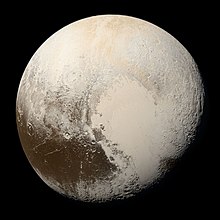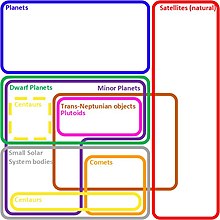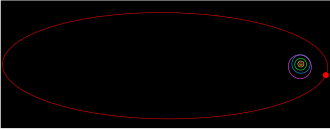Trans-Neptunian object
They are thought to be composed of mixtures of rock, amorphous carbon and volatile ices such as water and methane, coated with tholins and other organic compounds.After Pluto's discovery, American astronomer Clyde Tombaugh continued searching for some years for similar objects but found none.For a long time, no one searched for other TNOs as it was generally believed that Pluto, which up to August 2006 was classified as a planet, was the only major object beyond Neptune.Eris, the most massive TNO, was discovered in 2005, revisiting a long-running dispute within the scientific community over the classification of large TNOs, and whether objects like Pluto can be considered planets.However, the interpretations are typically ambiguous as the spectra can fit more than one model of the surface composition and depend on the unknown particle size.More significantly, the optical surfaces of small bodies are subject to modification by intense radiation, solar wind and micrometeorites.Small TNOs are thought to be low-density mixtures of rock and ice with some organic (carbon-containing) surface material such as tholins, detected in their spectra.[17] Colour indices are simple measures of the differences in the apparent magnitude of an object seen through blue (B), visible (V), i.e. green-yellow, and red (R) filters.[18] For reference, two moons, Triton and Phoebe, the centaur Pholus and the planet Mars are plotted (yellow labels, size not to scale).This distinction leads to suggestion that the surface of the largest bodies is covered with ices, hiding the redder, darker areas underneath.BR (intermediate blue-red) and IR (moderately red) differ mostly in the infrared bands I, J and H. Typical models of the surface include water ice, amorphous carbon, silicates and organic macromolecules, named tholins, created by intense radiation.The intensity of light illuminating the object is known (from its distance to the Sun), and one assumes that most of its surface is in thermal equilibrium (usually not a bad assumption for an airless body).Thus there are two unknowns (albedo and size), which can be determined by two independent measurements (of the amount of reflected light and emitted infrared heat radiation).[36] The existence of planets beyond Neptune, ranging from less than an Earth mass (Sub-Earth) up to a brown dwarf has been often postulated[37][38] for different theoretical reasons to explain several observed or speculated features of the Kuiper belt and the Oort cloud.










Planets beyond Neptunedistant minor planetsCentaursNeptune trojansKuiper belt objectsClassical KBOsResonant KBOsPlutinosScattered disc objectsResonant SDOsExtreme trans-Neptunian objectDetached objectsSednoidsOort cloud objectsminor planetSolar SystemorbitsNeptunesemi-major axisastronomical unitsclassicalresonantKuiper beltscattered disc1006 numbered4,000 unnumbered TNOsdiscovered was Pluto15760 AlbionHaumeaMakemakeGonggongamorphous carbonmethanetholinsperihelionextreme trans-Neptunian objectsNew Horizonsgravitationaldiscovery of PlutoVoyager 2apparent magnitudeeclipticClyde Tombaughdwarf planetsInternational Astronomical UnionEuler diagramorbital parametersResonant objectsclassical Kuiper belt objects(87269) 2000 OO67resonant trans-Neptunian objecttwotinosQuaoargravitational scatteringabsolute magnitudeJupiter-family cometsTisserand parameterperiheliaperturbationsgiant planetsgalactic tidespassing starcolour indicesapparent magnitudesspectrainfraredTritonPhoebesolar windmicrometeoritesregolithorganiccarboncomets2060 Chiron7968 Elst–PizarroAsteroid color indicesPholusClassical Kuiper belt objectDeep Ecliptic Surveydynamical groupsouter Solar SystemCubewanosJupiter trojansAsteroid spectral typessilicatesethanemethanolinvariable planediameteroccultationthermalalbedomicrometreswavelengthSpitzer Space TelescopeList of trans-Neptunian objectsList of unnumbered trans-Neptunian objects134340 Plutosystem of five satellitesplutino(385185) 1993 RO(15874) 1996 TL661998 WW3147171 Lempo20000 Varuna28978 Ixion50000 QuaoarWeywotRoche limit90377 Sedna90482 Orcus136108 HaumeaHaumea collisional family136472 Makemake136199 ErisDysnomia(612911) 2004 XR190detached object225088 GonggongXiangliu(528219) 2008 KV42471325 Taowu2012 VP113486958 Arrokoth2018 VG18